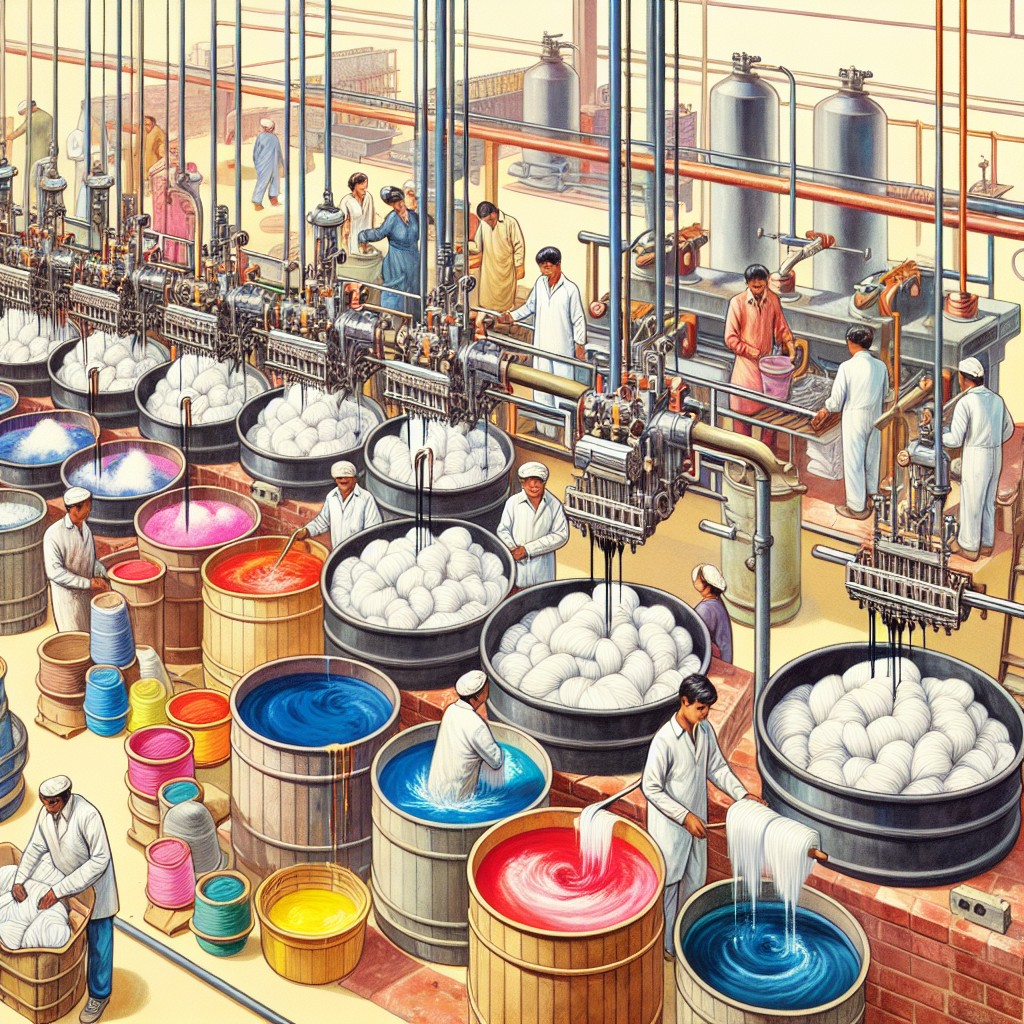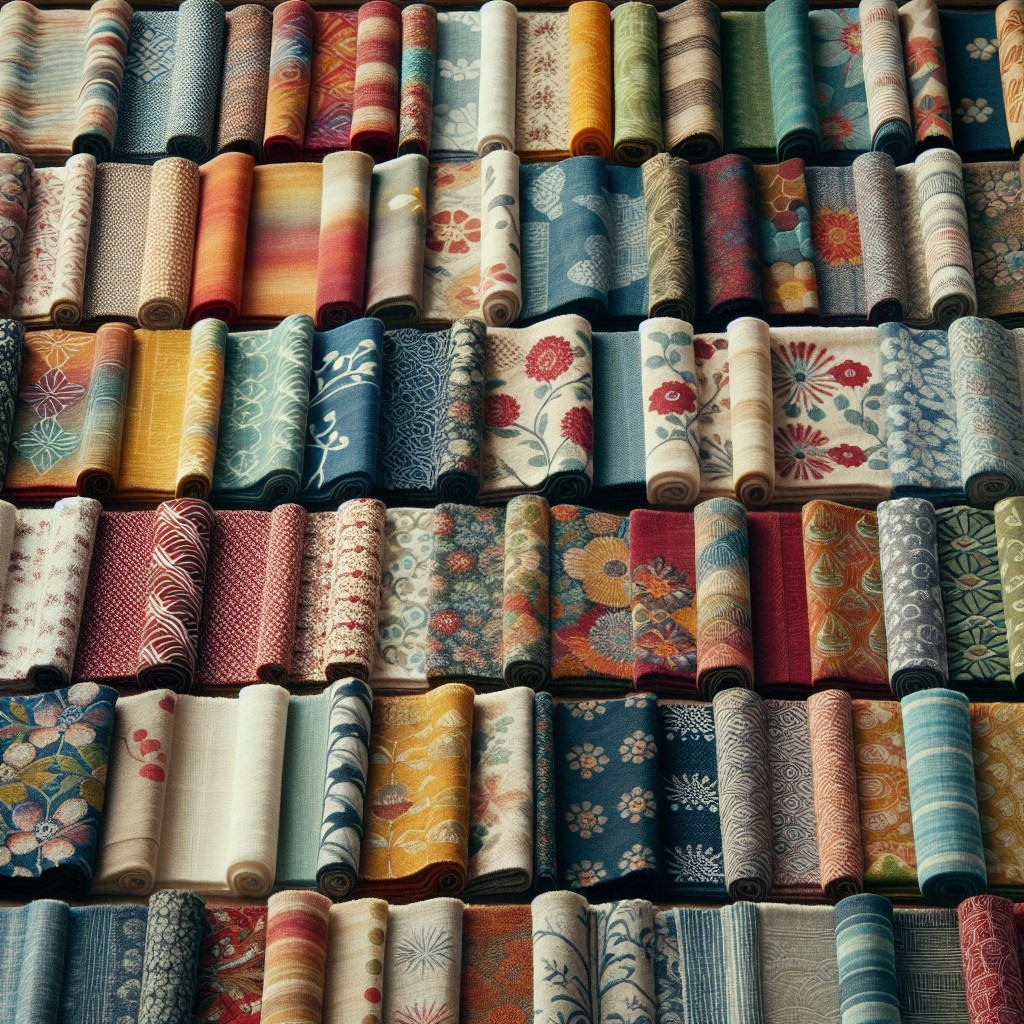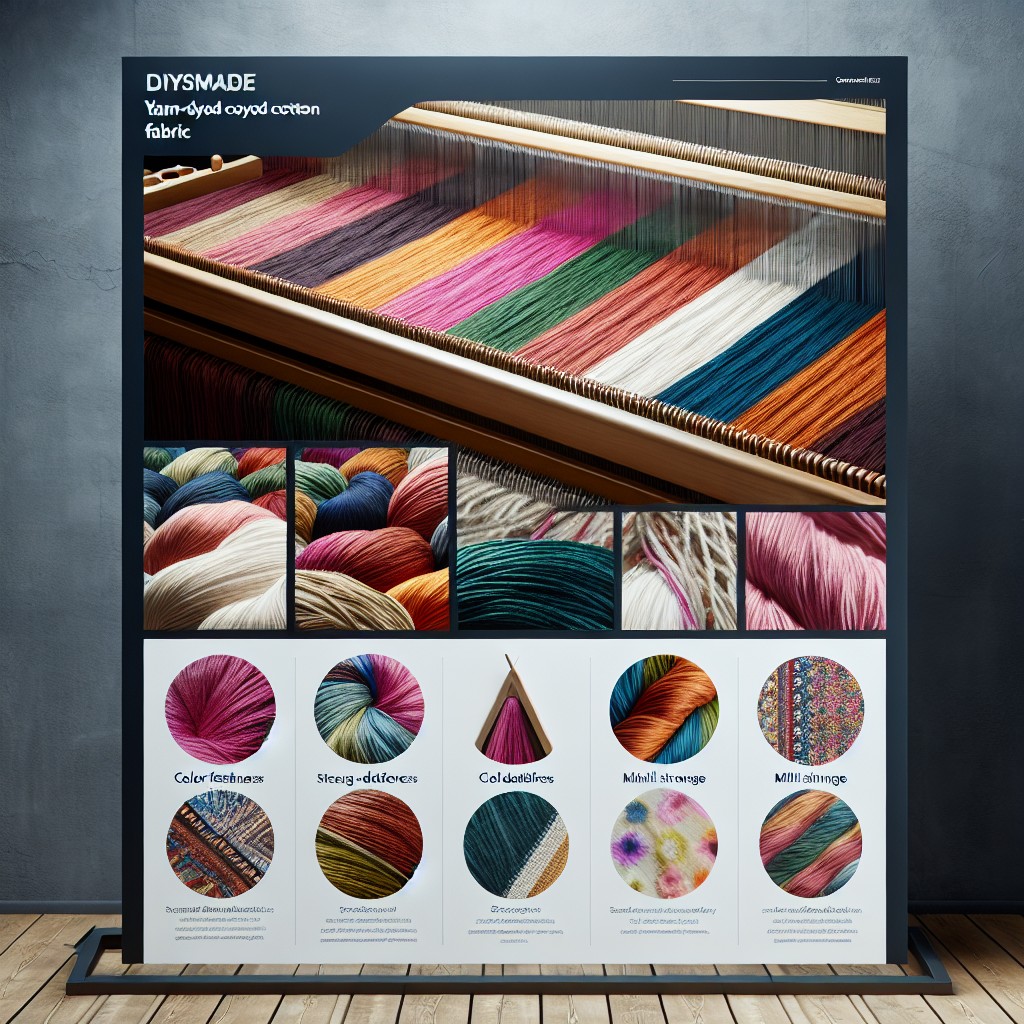Discover the vibrant world of yarn-dyed cotton fabrics as we delve into their various types and explore their unique characteristics in this informative blog post.
Welcome to my blog where I share my passion for all things yarn-related! Today, we’re going to dive into the world of yarn-dyed cotton fabrics. If you’re a fan of crochet or knitting, then you know that the type of yarn you use can make a huge difference in your finished project.
But have you ever considered the impact that the fabric itself can have on your work? Yarn-dyed cotton fabrics come in a variety of types and each offers its own unique benefits. From plain weave to twill, we’ll explore the different types of yarn-dyed cotton fabrics and how they can elevate your crafting game.
So grab your hook or needles and let’s get started!
Introduction to Yarn Dyed Cotton Fabrics

Yarn-dyed cotton fabrics are a popular choice among crafters and designers alike. Unlike piece-dyed cotton, where the fabric is dyed after it has been woven, yarn-dyed cotton involves dyeing the individual threads before they are woven together to create the fabric.
This process results in a more vibrant and long-lasting color that won’t fade or bleed over time.
One of the most significant advantages of using yarn-dyed cotton fabrics is their versatility. They come in various weaves, patterns, and colors that can be used for different applications such as clothing items like shirts or dresses to home decor items like curtains or tablecloths.
In addition to their aesthetic appeal, these types of fabrics also offer practical benefits such as durability and breathability making them ideal for everyday use.
Yarn Dyeing Process

Unlike piece-dyed fabrics, where the fabric is dyed after it has been woven, yarn-dyed cotton involves dyeing the individual threads before they are woven into fabric. This allows for more intricate patterns and designs to be created.
There are several methods of yarn dyeing including skein dyeing, hank dyeing, package or cone dying and space or beam dying. In skein/hank/beam/space dying method of coloring fibers; fiber strands (skeins) are wound around a reel that rotates on an axis while being immersed in hot water containing dyes.
One advantage of this process is that it creates colorfastness since each thread has absorbed the color throughout its entire length rather than just on its surface like with piece dyed fabrics. In addition to producing long-lasting colors, this technique also allows for greater control over pattern placement within the finished product.
Characteristics of Yarn Dyed Fabrics

One of the most notable features is their colorfastness, which means that the colors are less likely to fade or bleed over time. This is because yarn-dyed cotton fibers are dyed before they’re woven into fabric, ensuring that each individual fiber is fully saturated with color.
Another characteristic of yarn-dyed cotton fabrics is their durability and strength. Because the dye penetrates deep into each fiber, it creates a more stable structure than piece-dyeing methods where only the surface fibers are colored.
In addition to being long-lasting and vibrant in color, yarn dyed-cottons also offer a wide range of textures and patterns due to different weaving techniques used during production. From plain weave for crisp shirting materials to twill weaves for heavier denim-like textiles – there’s something for every project!
Benefits of Yarn Dyed Cotton

One of the most significant advantages is their durability. The yarn dyeing process ensures that the color penetrates deep into each fiber, resulting in long-lasting and vibrant hues that won’t fade or bleed over time.
Another benefit is their versatility. Yarn-dyed cotton fabrics come in a variety of weaves and patterns, making them suitable for various applications such as clothing, home decor items like curtains or tablecloths, bags and accessories like totes or backpacks.
These types of fabrics are breathable which makes them ideal for summer garments since they allow air to circulate freely through the fibers keeping you cool even on hot days.
Lastly but not least important is sustainability; yarn dyed cotton production uses less water than piece dyeing methods which means it’s more eco-friendly while still producing high-quality textiles with minimal environmental impact.
Types of Yarn Dyed Cotton Weaves

The most common types of yarn-dyed cotton weaves include plain weave, twill weave, and satin weave.
Plain Weave: This is the simplest type of yarn-dyed cotton fabric. It features an over-under pattern that creates a flat surface with no visible diagonal lines.
Twill Weave: Twill-weave yarn dyed fabrics are characterized by their diagonal lines or ridges on the surface. They are created by weaving the threads over two or more warp threads before passing under one thread to create a distinctive pattern.
Satin Weave: Satin-weaved yarn dyed fabrics have long floats (threads that extend across several other threads) which give them their characteristic sheen and smoothness. These types of fabric tend to be more delicate than plain or twill-woven varieties but can add elegance to any project they’re used for.
Popular Yarn Dyed Cotton Patterns
From classic stripes to intricate plaids and checks, there’s a pattern for every taste and style. One of the most popular patterns in yarn-dyed cotton is gingham – a timeless design that has been around for centuries.
Gingham is characterized by its simple checkered pattern with alternating colored squares of equal size. Another beloved pattern in yarn-dyed cotton is houndstooth – a distinctive design featuring jagged black-and-white or brown-and-tan checks that resemble the teeth of a hound dog (hence its name).
Houndstooth can add an elegant touch to any project, from scarves and shawls to jackets and skirts. If you’re looking for something more playful, polka dots are always fun! Yarn dyed polka dot fabrics come in various sizes ranging from tiny dots on solid backgrounds to larger ones on contrasting colors.
Whether you prefer traditional designs or modern prints, there’s no shortage of options when it comes to popular patterns in yarn dyed cotton fabrics. So go ahead and experiment with different styles until you find your perfect match!
Yarn Dyed Cotton Vs. Piece Dyed Cotton
While both techniques involve adding color to the fabric, they differ in how the dye is applied.
Piece dyed cotton involves dying a completed piece of fabric after it has been woven or knitted. This method is often used for solid-colored fabrics and allows for quick production times as large quantities can be dyed at once.
On the other hand, yarn-dyed cotton involves dying individual threads before weaving or knitting them into a finished product. This process creates more intricate patterns and designs that cannot be achieved with piece dyeing alone.
One of the benefits of using yarn-dyed cotton over piece dyeding is that it results in colors that are more vibrant and long-lasting due to each thread being fully saturated with color before being woven together. Because each thread is individually colored prior to weaving/knitting, this technique allows for greater design flexibility when creating complex patterns such as plaids or stripes.
Essex Linen/Cotton Yarn Dyed Fabrics
This fabric is made from a blend of linen and cotton, which gives it the durability of cotton with the texture and drape of linen. The yarn-dyed process adds depth to the colors, making them more vibrant than piece-dyed fabrics.
One unique characteristic of Essex Linen/Cotton Yarn Dyed Fabrics is their versatility. They can be used for a variety of projects such as clothing, home decor items like curtains or tablecloths, or even quilting.
When working with this type of fabric, it’s important to keep in mind that due to its blend composition there may be some shrinkage after washing so pre-washing before cutting your project pieces is recommended.
Kitchen Window Wovens Cotton Fabrics
These fabrics are known for their durability, absorbency, and resistance to stains. They come in a variety of patterns such as checks, stripes, plaids or gingham which can add an element of charm to any kitchen decor.
Whether you’re making dish towels or pot holders, Kitchen Window Wovens Cotton Fabrics offer the perfect combination of style and functionality. The tight weave makes them ideal for projects that require high absorbency like napkins or tablecloths while the vibrant colors make them great choices for decorative accents like curtains or seat cushions.
One thing to keep in mind when working with Kitchen Window Woven Cotton Fabrics is that they tend to shrink after washing so it’s important to pre-wash your fabric before starting your project. These fabrics may wrinkle easily but ironing on low heat should help smooth out any wrinkles without damaging the fibers.
Designer Deadstock Two-Tone Linen
This unique fabric features two different colors woven together, creating a stunning visual effect. The term “deadstock” refers to unused or leftover fabrics from fashion houses and textile mills, which are then repurposed into new designs.
This linen is perfect for creating statement pieces such as dresses, skirts or blouses that will stand out in any wardrobe. Its lightweight texture makes it ideal for summer clothing while its durability ensures longevity.
The Designer Deadstock Two-Tone Linen comes in various color combinations and patterns making it versatile enough to suit any style preference. It’s also an eco-friendly option since the use of deadstock materials reduces waste and promotes sustainability within the fashion industry.
When working with this fabric, be sure to pre-wash it before cutting as some shrinkage may occur due to its natural fiber content. Using sharp scissors when cutting will ensure clean edges without fraying.
Applications of Yarn Dyed Cotton Fabrics
They are perfect for creating clothing, home decor items, and accessories. The unique patterns and colors of yarn-dyed cotton fabrics make them ideal for adding interest to any project.
For clothing, yarn-dyed cotton is often used to create shirts, dresses, skirts or pants that have a more structured look than regular printed fabric. Yarn dyed checks or stripes add depth to the garment design while still being subtle enough not to overpower it.
In home decor projects such as curtains or tablecloths where durability is important but you also want something with visual appeal then yarn dyed fabric would be an excellent choice because they hold up well over time without fading like some printed fabrics do.
Accessories such as bags made from these types of materials will stand out due to their unique texture and color combinations which can range from bold brights through muted pastels depending on your preference.
Tips for Sewing With Yarn Dyed Cotton
Here are some tips to help you get the best results when working with these beautiful textiles:.
1. Pre-wash your fabric: Yarn-dyed cotton fabrics tend to shrink after washing, so it’s important to pre-wash them before cutting and sewing.
2. Use sharp needles: A dull needle can damage the delicate fibers of yarn-dyed cotton fabric, causing snags or runs in the weave.
3. Choose appropriate thread: Select high-quality thread that matches your fabric color for a seamless finish.
4. Press carefully: When pressing seams or hems on yarn-dyed cotton fabrics, use low heat and press gently from the wrong side of the fabric to avoid flattening any texture or pattern in your design.
5. Consider interfacing options: Depending on what you’re making, adding interfacing may help stabilize certain areas of your project such as collars and cuffs while maintaining flexibility elsewhere.
Yarn Dyed Cotton Fabric Care
However, proper care is essential to maintain their quality and longevity. Here are some tips for caring for your yarn-dyed cotton fabric:
- Machine wash on a gentle cycle with cold water.
- Use mild detergent and avoid bleach or fabric softeners.
- Hang dry or lay flat to dry instead of using a dryer as high heat can damage the fibers.
- Iron on low heat if necessary, avoiding direct contact with the iron.
Sustainability in Yarn Dyed Cotton Production
Fortunately, many manufacturers are taking steps towards sustainability in their production processes. One such example is using organic cotton for yarn dyeing instead of conventional cotton which requires large amounts of water and pesticides.
Another sustainable practice is utilizing natural dyes made from plants like indigo or madder root instead of synthetic dyes which can be harmful to both workers and the environment. Some companies have implemented closed-loop systems where wastewater from dyeing processes is treated and reused rather than being released into nearby bodies of water.
By choosing sustainably produced yarn-dyed cotton fabrics for your projects, you’re not only supporting environmentally conscious practices but also ensuring a healthier future for our planet. So next time you’re shopping for fabric or planning your next project, consider opting for sustainable options!
FAQ
What are the types of yarn dyed fabric?
Answer: The types of yarn dyed fabric include stripes, checks, plaids, gingham, dotted or cross patterns, Dobby type weaving process with tiny crosses, dots, or lines, and denim.
What is yarn dyed cotton fabric?
Yarn dyed cotton fabric refers to a textile made of colored yarns woven into a pattern or design, creating distinctive and textural fabrics with motifs sewn directly into the material rather than printed on top.
What are yarn dyed fabric swatches called?
Answer: Yarn dyed fabric swatches are called handlooms.
What is the difference between yarn dyed and piece dyed fabric?
The difference between yarn dyed and piece dyed fabric is that yarn dyed fabric involves dyeing the yarns before weaving or knitting (e.g., checks, stripes, and denim), while piece dyed fabric is dyed after the fabric is made with grey yarns.
What are the advantages of using yarn dyed cotton fabric in fashion and home textiles?
Answer: The advantages of using yarn dyed cotton fabric in fashion and home textiles include enhanced durability, colorfastness, and richer texture appearance.
How is the yarn dyeing process different from other fabric dyeing techniques?
"In the yarn dyeing process, the color is applied to the yarns before being woven or knitted into the fabric, whereas in other fabric dyeing techniques, color is applied to the whole, finished fabric."
What factors should be considered when selecting yarn dyed cotton fabric for a project?
Dyed_cotton_fabric_selection_factors: color_fastness, fabric_weight, shrinkage_rate, weave_type, pattern, and intended_project_use.
